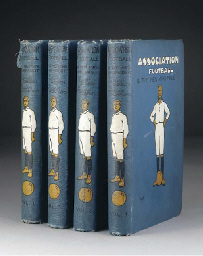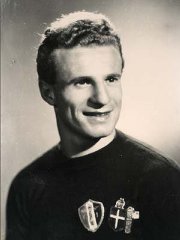10. Calcio (John Foot, 2006)
By breaking up the book into thematic chapters which are subdivided into further smaller sections one might expect the narrative flow of Foot’s reflection on the Italian game to be lost. Instead the structure of Calcio is ideally suited to conveying a vast amount of information in a clear and readable fashion. That arguably is one of the key differences between this and many other books based around football in a single country, the football is the focus rather than the author’s reflection on the cultural nuances of that land. Particular highlights include sections on Italian playmakers, scandals and the role of the referee. Few could come away from Calcio without learning something.
9. The Glory Game (Hunter Davies, 1973)
Unquestionably one of the classics of football literature, The Glory Game offers a unique insight into the workings of one of the nation’s greatest clubs. As Davies spent a whole season with privileged access at White Hart Lane he was able to witness the detailed goings on that had never before been reported. In telling the tale of a Davies holds nothing back, but he lets the figures involved tell much of the story and their comments ring true. Perhaps then it is unsurprising that no club have chosen to repeat the experiment since. A fascinating snapshot of the era.
8. Garrincha (Ruy Castro, 2004)
In the contemporary football lexicon players who are referred to as a “character” or a “maverick” tend to be ones whose off-field antics compensated for a distinct lack of talent or those who failed to make anything of the gifts they did have. Garrincha was both a character and a maverick and yet precious few players in the game’s history could match his achievements. Castro’s book tells us much about the footballing abilities of the man who was known as “The Joy of the People”, how he came to become a two-time World Cup winner and his glorious years with Botafogo but what lingers in the memory are the unique anecdotes of Garrincha’s life. The tragedy of his drinking, the IQ test which should have barred him from representing Brazil and, yes, losing his virginity to a goat, all great stories are featured here. You can’t help but read this and reflect that there will never be another Garrincha.
7. The Ball is Round (David Goldblatt, 2006)
A work of spectacular ambition, Goldblatt more than succeeds in his attempt to provide a truly global history of the game. Primarily a chronological journey through the story of football ,Goldblatt’s thematic approach provides a diversity to the book which few can rival. Happy to be discussing the architecture of Le Corbusier, the politics of South America and the increasing role of the media The Ball is Round ties all the threads together and demonstrates quite how far reaching the influence of the game is. This book is a genuine football epic. Breathtaking.
6. Soccer Revolution (Willy Meisl, 1955)
Arguably the most prescient football book ever written. Meisl (the brother of Austrian Wunderteam coach, Hugo) charts the history of English football and studies the mistakes that led England to their 1953 humbling at the hands of Hungary. The changes advocated by Meisl, who saw himself as an adopted Englishman, were the same that now meet England’s biennial tournament disasters. Meisl is strongly in favour of improving the technical ability of English players and promotes the concept of the “whirl”, effectively “total football”, as the route to success. The fact that such flaws have gone uncorrected for almost 60 years only serves to underline the enduring resonance of this masterpiece.
5. Association Football and the Men Who Made It (Alfred Gibson and William Pickford, 1906)
The holy grail for any serious collector of football literature, this work is unrivalled in affording the contemporary reader a detailed understanding of the teams, players and administrators who dominated the game in the nineteenth century. Set across four volumes, the figures profiled inside are almost universally forgotten to modern football fans and yet the calibre of the writing within makes them come alive. Even though the game they played was markedly different to that of the current day, the vitality and energy of the era is clear. If you have upwards of £500 lying around you could do far worse than making an investment in this classic tome.
4. Inverting the Pyramid (Jonathan Wilson, 2008)
Although not the first man to attempt to chart a detailed history of tactics (as well as Bernard Joy’s Soccer Tactics, Andy Gray penned a useful volume prior to his Sky Sports disgrace) Wilson’s contribution to the field feels definitive. Succinct and elegant prose carries the reader from the game’s earliest years to the modern day and demonstrates a real understanding of why many of the most profound changes took place. It’s not perfect, changes in Sweden’s tactics are partially attributed to a failure to qualify for the 1970 World Cup (they actually topped their group ahead of France and Norway) but such gripes are few and far between. Where Wilson really excels are his forays into Eastern Europe as he details at length the contributions of Victor Maslov and Boris Arkadiev. A supreme contribution to the field.
3. All Played Out (Pete Davies, 1990)
Afforded a remarkable level of access to players and management before and during England’s Italia 90 campaign, Davies’ book stands out for the brutal honesty of those he speaks to. There is still suspicion among the players for the interloper among them, engendered by a deep mistrust for the “rotters” (journalists from the tabloids so many of them had contracts with), but Davies manages to get them to open up and speak frankly. While the text itself is punchy and memorable these unguarded comments from the players themselves are to be treasured. Immensely evocative, All Played Out takes you back to what remains for many English football fans one of the most memorable summers of their lives.
2. The Story of the World Cup (Brian Glanville, Various)
Unquestionably there are more comprehensive and detailed books about the World Cup (Cris Freddi and Terry Crouch’s efforts both offer more information, statistics and data) but none rivals Glanville for the majesty of his prose. His fabulous descriptions of key passages bring the games and tournaments to life in a way that no other writer has yet managed. In places it feels outdated (regular references to “negro” players stand out in 2011), but this reflects the fact that the book was first published following the 1970 tournament and has been reissued every four years with an additional chapter included. At its best Glanville’s lively and exhilarative narrative possesses the remarkable beauty that he is so proficient at describing.
1. Association Football (A.H Fabian and Geoffrey Green –Eds, 1960)
Simply staggering in the breadth of topics covered, the depth of the articles and the devotion of those who put together this classic work. Featuring contributions from players like Billy Wright and Stanley Matthews as well as journalists Bernard Joy and Willy Meisl, no football book has ever come so close to perfection. Every section is authoritative and comprehensively researched and many remain unsurpassed in the intervening 50 years. Obvious highlights include a review of football at the Olympics and a discussion between Danny Blanchflower, Ted Drake and Geoffrey Green of the development of the game in the twentieth century. If you only own one football book, make it this!























